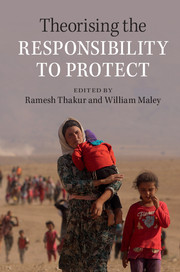Book contents
- Frontmatter
- Contents
- List of figures
- Notes on contributors
- Part I Context
- Part II The Responsibility to Protect, normative theory and global governance
- 5 The Responsibility to Protect and world order
- 6 International law and the Responsibility to Protect
- 7 The Responsibility to Protect, multilateralism and international legitimacy
- 8 Global governance and the Responsibility to Protect
- 9 International law, the Responsibility to Protect and international crises
- 10 The Responsibility to Protect and the just war tradition
- 11 War is not the answer: the Responsibility to Protect and military intervention
- Part III The Responsibility to Protect and international social purposes
- Index
6 - International law and the Responsibility to Protect
from Part II - The Responsibility to Protect, normative theory and global governance
Published online by Cambridge University Press: 05 August 2015
- Frontmatter
- Contents
- List of figures
- Notes on contributors
- Part I Context
- Part II The Responsibility to Protect, normative theory and global governance
- 5 The Responsibility to Protect and world order
- 6 International law and the Responsibility to Protect
- 7 The Responsibility to Protect, multilateralism and international legitimacy
- 8 Global governance and the Responsibility to Protect
- 9 International law, the Responsibility to Protect and international crises
- 10 The Responsibility to Protect and the just war tradition
- 11 War is not the answer: the Responsibility to Protect and military intervention
- Part III The Responsibility to Protect and international social purposes
- Index
Summary
‘We surely have a responsibility to act when a nation's people are subjected to a regime such as Saddam's’. During its short life, the Responsibility to Protect (R2P) has experienced gains and setbacks, with the greatest setback coming in March 2004 when Tony Blair invoked the concept in an attempt to justify the previous year's invasion of Iraq.
R2P is of interest to international lawyers and international relations scholars alike. It is a result of ‘norm entrepreneurship’. It achieved prominence quickly, with only four years separating its birth in 2001 from its inclusion in the United Nations World Summit Outcome Document in 2005. But with success came controversy and compromise. On the key issue of the use of military force, R2P has – by widespread agreement – been confined to the context of UN Security Council decision-making, where it remains permissive but non-binding.
This chapter examines the interaction between R2P, the prohibition on the use of force set out in the UN Charter and the discretionary power of the Security Council to determine the existence of a ‘threat to the peace’ and authorise military action. It asks: to what degree, if any, has R2P become part of contemporary international law concerning the use of force? And what does the history of R2P tell us, more generally, about ‘norm entrepreneurship’ and processes of legal change?
The chapter concludes that R2P has neither acquired legal status as a new exception to the prohibition on the use of force, nor exerted much influence on the rest of the international legal system. At the same time, the concept may – on an ad hoc basis – be influencing how states respond when another state violates the law while seeking to prevent atrocities. If so, the principal legal effect of R2P might concern mitigation of the consequences of rule breaking, rather than any changes to the rules themselves.
The development of R2P
The central obligation of the 1945 UN Charter is set out in Article 2(4): ‘All Members shall refrain in their international relations from the threat or use of force against the territorial integrity or political independence of any state, or in any other manner inconsistent with the Purposes of the United Nations.’
- Type
- Chapter
- Information
- Theorising the Responsibility to Protect , pp. 101 - 124Publisher: Cambridge University PressPrint publication year: 2015
- 4
- Cited by



